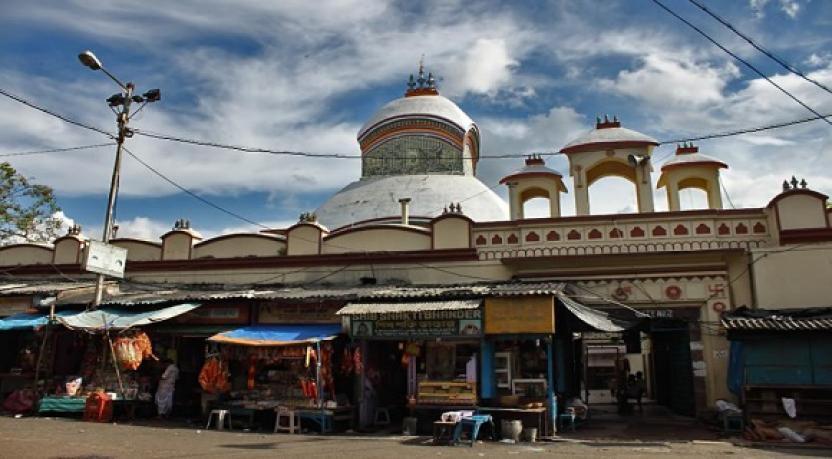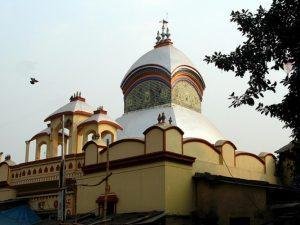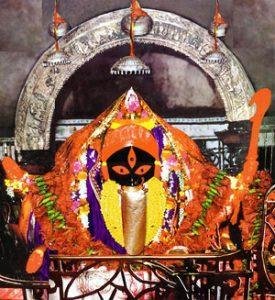Kalighat Kali Temple, Kolkata, West Bengal
| Date built: | 1809 |
|---|---|
| Deity: | Kali |
| Architectural style: | Bengal architecture |
| Major festivals | Kali Puja |
| Locale: | Kolkata |
| District:: | Kolkata |
| Address: |
Anami Sangha, Kalighat, Kolkata, West Bengal 700026
|
| Phone | 03322436440 |
Kalighat Kali Temple is a Hindu temple in West Bengal, India dedicated to the Hindu goddess Kali. It is one of the 51 Shakti Peethas.
Kalighat was a Ghat (landing stage) sacred to Kali on the old course of the Hooghly river (Bhāgirathi) in the city of Calcutta. The name Calcutta is said to have been derived from the word Kalighat. The river over a period of time has moved away from the temple. The temple is now on the banks of a small canal called Adi Ganga which connects to the Hoogly. The Adi Ganga was the original course of the river Hoogly. Hence the name Adi (original) Ganga.
Architecture
The Temple at Kalighat is revered as an important Shakti Peetha, by the Shaktism sect of Hinduism. The mythology of Daksha yajna and Sati’s self immolation is the story behind the origin of Shakti Peethas.
Daksha, the son of Brahma was an ancient entity called Prajapati or the keeper of the beings in Hinduism. He had a lot of daughters, one of whom was Sati, an incarnation of the Primordial Mother Goddess or Shakti. She was married to Shiva, the ascetic, whose abode was in the cold and snowy recesses of the Kailasa Parvat. Daksha had frowned upon the marriage, as Shiva was a penniless man, quite unlike the King that Daksha was. In time, Daksha decided that he would arrange a yajna or a ritual where he would invite all the gods, except for Shiva. Sati, his daughter came to her father’s place, uninvited and faced a flurry of insults from her father about her husband. Unable to bear the insults, she immolated herself. The news of the death of his beloved wife set Shiva on a delirious rage, as he started the Tandav or the Dance of Destruction with the body of Sati, calming down, only when Vishnu managed to chop her body down into fifty one pieces, which would fall all over the length and breadth of India. (A lot of these places are in modern day Pakistan and Bangladesh as well.)
Shakti Peethas or divine seats of Shakti or the Primordial Mother Goddess, thus came into being wherever these severed parts of Sati’s body had fallen.
Each of the 51 Peethas have a temple dedicated to the Shakti or the Primordial Mother, and a temple dedicated to the Bhairava or Shiva, the All-Father, essentially forming important historical centres to mark the marriage of Shaivism and Shaktism, and also the philosophical fact that a man is nothing without his Shakti or Woman and vice versa.
The Shakti here is thus Dakshina Kali (the benevolent Mother of the World) while the Bhairav being Nakulish or Nakuleshwar.
It is believed that the right big toe of Sati fell here at Kalighat. However, some Puranas also mention that the Mukha Khanda (face) of the Goddess fell here, got fossilized, and is stored and worshipped here.
The 51 Shakti Peethas are linked to the 51 alphabets in Sanskrit, each carrying the power to invoke one of the goddesses associated with them. These Alphabets are called Beeja Mantras or the seeds of the primordial sounds of creation. The Beeja Mantra for Dakshina Kali is Krīm.
The mythological texts which include the Kalika Purana (Ashtashakti,) recognize the four major Shakti Peethas — Bimala where resides the Pada Khanda (feet) (the temple is inside the Jagannath Temple, Puri, Odisha), Tara Tarini housing the Stana Khanda (Breasts), (near Brahmapur, Odisha), Kamakshya, Yoni khanda (vagina) (near Guwahati, Assam) and Dakshina Kalika, Mukha khanda (in Kolkata, West Bengal) originated from the lifeless body of the goddess Sati.
Legend / Local stories
The Kalighat temple in its present form is only about 200 years old, although it has been referred to in Mansar Bhasan composed in the 15th century, and in Kavi Kankan Chandi of the 17th century.The present structure of the temple was completed under the Sabarna Roy Chowdhury family’s patronage in 1809. Mention of the Kali temple is also found in Lalmohon Bidyanidhis’s ‘Sambanda Nirnoy”.Only two types of coins of Chandragupta II, who incorporated Vanga in the Gupta Empire, are known from Bengal. His Archer type coins, which became the most popular type of coinage with the Gupta rulers after Kumaragupta I, have been found in Kalighat. This is evidence of the antiquity of the place.The image of Kali in this temple is unique. It does not follow the pattern of other Kali images in Bengal. The present idol of touchstone was created by two saints – Atmaram Brahmachari and Brahmananda Giri. Presently, the three huge eyes, long protruding tongue made of gold and four hands, which all are made of gold too. Two of these hands holding a scimitar and a severed head of the asura king ‘Shumbha’. The scimitar signifies Divine Knowledge and the asura (or, human) head signifies human Ego which must be slain by Divine Knowledge in order to attain Moksha. The other two hands are in the abhaya and varada mudras or blessings, which means her initiated devotees (or anyone worshiping her with a true heart) will be saved as she will guide them here and hereafter.
Kalighat is regarded as one of the 51 Shakti Peethas of India, where the various parts of Sati’s body are said to have fallen, in the course of Shiva’s Rudra Tandava. Kalighat represents the site where the toes of the right foot of Dakshayani or Sati fell.
Kalighat is also associated with the worship offered to Kali by a Dasanami Monk by name Chowranga Giri, and the Chowringee area of Calcutta is said to have been named after him.
Photo Gallery
How to Reach:
Contact Details
Official Address







